Samsung Galaxy S 4 Review - Part 1
by Brian Klug on April 24, 2013 12:01 AM ESTDisplay
We wrote about how we suspected that SGS4 would go to a 5-inch 1080p SAMOLED display just after CES. Turns out that was spot on, as the SGS4 includes a 5-inch 1080p Full HD SAMOLED panel, the latest in Samsung's AMOLED roadmap. Samsung's naming stays true, and there's no Plus tacked on at the end, so we get another non-RGB stripe subpixel geometry with SGS4. The last few Samsung AMOLED variants we've seen have had different subpixel grids, and the one on the SGS4 is possibly the most interesting to date. There's still a bias toward more green subpixels than blue or red, this isn't an RGB stripe at all, but instead of the previous RG,BG layout we see this offset pattern with green on one line, then blue and red on another line. Interestingly enough the blue subpixel appears to be a square, and red and green appear to be circles, with the difference in area possibly offsetting the luminous efficiency of each material. Whatever the reason (Samsung has never been official or forthcoming any of these subpixel patterns each time they've changed them) it's present on the SGS4.
At this size however I have to admit that I find the pursuit of the subpixel geometry more of an educational one than something which affects users. While I could occasionally see it on the SGS3, I definitely do not see it on SGS4. The subpixels are now small enough that whatever the pattern, it all looks like a homogenous light-emitting surface, which was the goal after all. I could bring up the visual acuity discussion again but just trust me that it's small enough to not be visible even with actually perfect (not legally perfect, which is different) vision.
So resolution is great and up to par with all the other LCD-bearing flagships this year, lack of RGB stripe notwithstanding. There's that remaining question about brightness, contrast, outdoor visibility, and of course calibration and the saturation issue that has persisted with AMOLED from generation to generation.
On the brightness front, the SGS4 includes dynamic contrast functions that cannot be disabled and change as a function of what is being displayed. There's an "auto adjust screen tone" checkbox under display but don't let that fool you, that doesn't disable dynamic contrast, just white point. Under screen mode are the mDNIe toggles we've seen on countless other previous Samsung Android phones with AMOLED panels, only here we notice something interesting. There have always been four toggles as long as this option has existed, only what's different is now, one of them is named "Professional photo." Reviews of other regional variants of the SGS4 have included the same button but marked "Adobe RGB." Oddly enough it seems that the North American versions at least have this renamed for some reason, but undoubtedly the function is the same. Many speculated that this is now a toggle for some full CMS (Color Management System) which "fixes" the inherent color space issues with AMOLED and oversaturation that occurs when looking at sRGB content on such devices. Unfortunately, I can confirm that my initial suspicions that this is just a continuation of the mDNIe (lite) settings from previous generation is in fact correct. I reverse engineered what I could of these settings from both kernel messages while changing the toggles, and looking at the kernel sources. Turns out that 'Professional photo' mode is actually the 'Natural' mode renamed from previous versions.
So the question was whether the color space or white point actually does change with this mode enabled. I ran the SGS4 through our display tests in each of the modes and think the full color space plot tells the story. The sanest of them all really ends up being the strangely-named 'Movie' mode. Professional photo gives the big gamut with a white point closer to 'Movie,' which is to say around 7000K, but it doesn't fundamentally change the still-present oversaturation or color management issue that exists in Android with these wide gamut displays. Most users admittedly don't care however and just see "bright" colors. Theres' an Auto mode as well which the device ships with that basically has a matrix of mDNIe settings for targeted applications (for example the Gallery, Browser, Video playback) and so forth get settings, which you can see in the kernel.
| CalMAN Display Comparison | ||||||||||||
| Metric | iPhone 5 | iPhone 4S | HTC One X | SGS3 | Samsung Galaxy Note 2 | Google Nexus 4 | HTC Droid DNA | HTC One | SGS4 | |||
| Grayscale 200nits Avg dE2000 | 3.564 | 6.162 | 6.609 | 4.578 | 5.867 | 7.686 | 6.738 | 5.391 | 7.511 | |||
| CCT Avg (K) | 6925 | 7171 | 5944 | 6809 | 7109 | 8506 | 8108 | 8118 | 7020 | |||
| Saturation Sweep Avg dE2000 | 3.591 | 8.787 | 5.066 | 5.460 | 7.986 | 8.517 | 5.856 | 3.365 | 7.823 | |||
| GMB ColorChecker Avg dE2000 | 4.747 | 6.328 | 6.963 | 7.322 | 8.185 | 7.531 | 6.687 | 4.656 | 7.440 | |||
In the "Movie" mode things are better controlled than the Note 2 on the GMB color checker card test, which is the most important one for me. White point is also no longer the crazy 8000K that we saw before, 7000K is commendable for Samsung at this point. Keep in mind that maximum brightness changes in each mode as well as we effectively clamp things, I measured a maximum of 319 nits in Dynamic mode, 311 nits in Movie mode, and 255 nits in Standard, for example.
Running the display at maximum brightness for too long will also get you into an overheating or thermal protection mode as well, which we've seen on countless other AMOLED variants. Most of the time I suspect users will run on Auto brightness however which keeps brightness down to a much lower level to save battery and prevent that from becoming a problem.
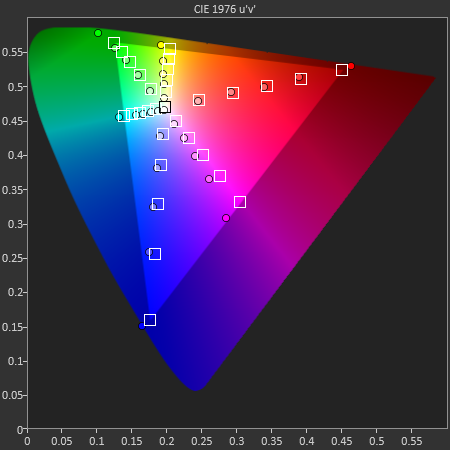
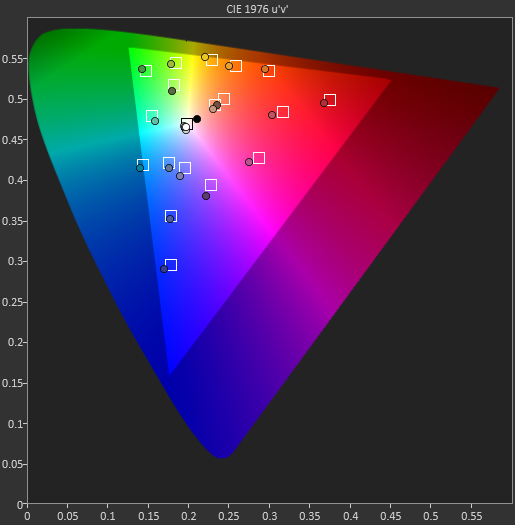
Because "Movie" was the closest to sRGB of all the modes, I selected it for the actual results that I'll present in the table. Admittedly this mode does tighten things up a bit, but it still isn't perfect and I'd still like to see Samsung do something to reign this in at some point.


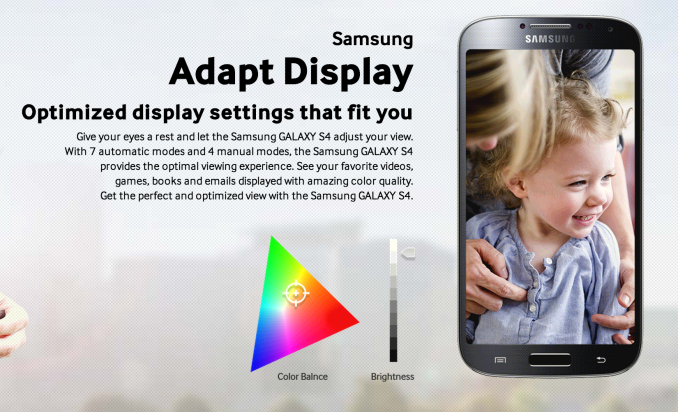




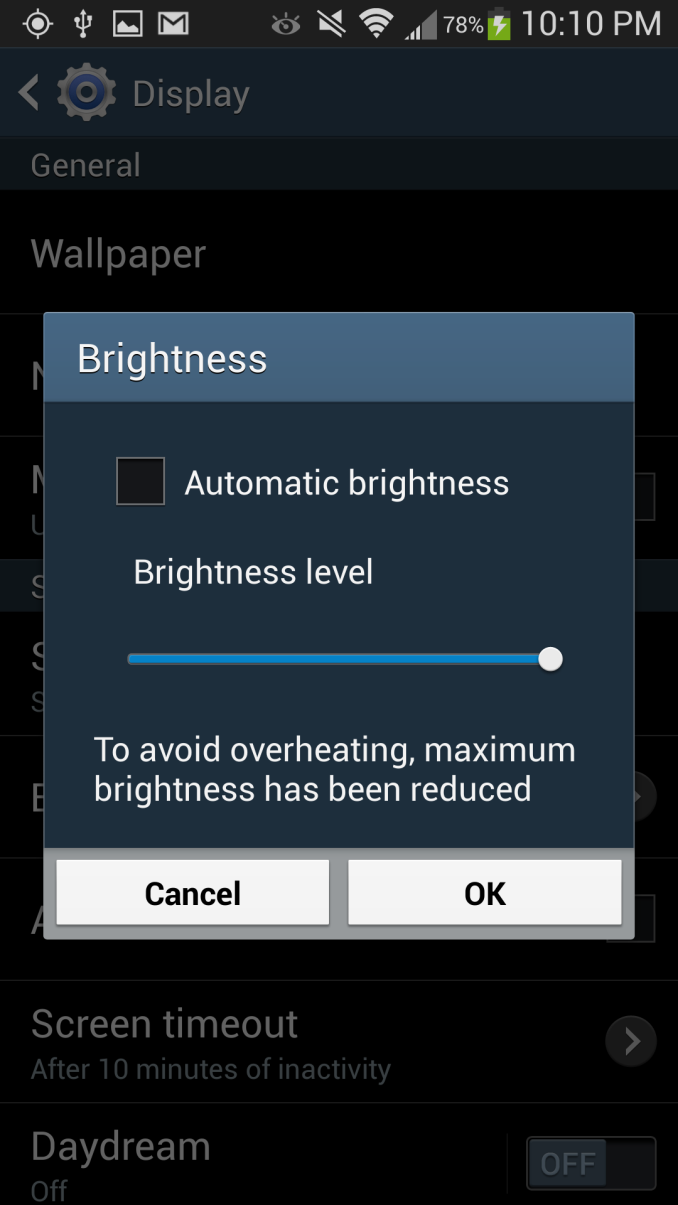
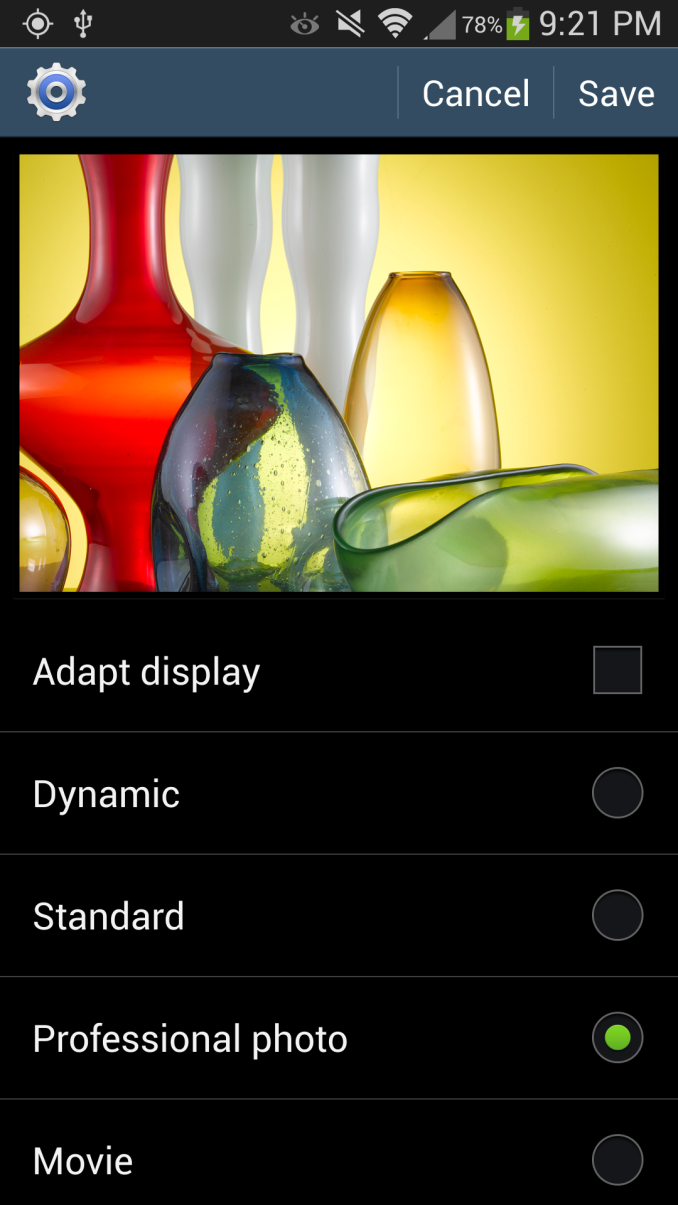
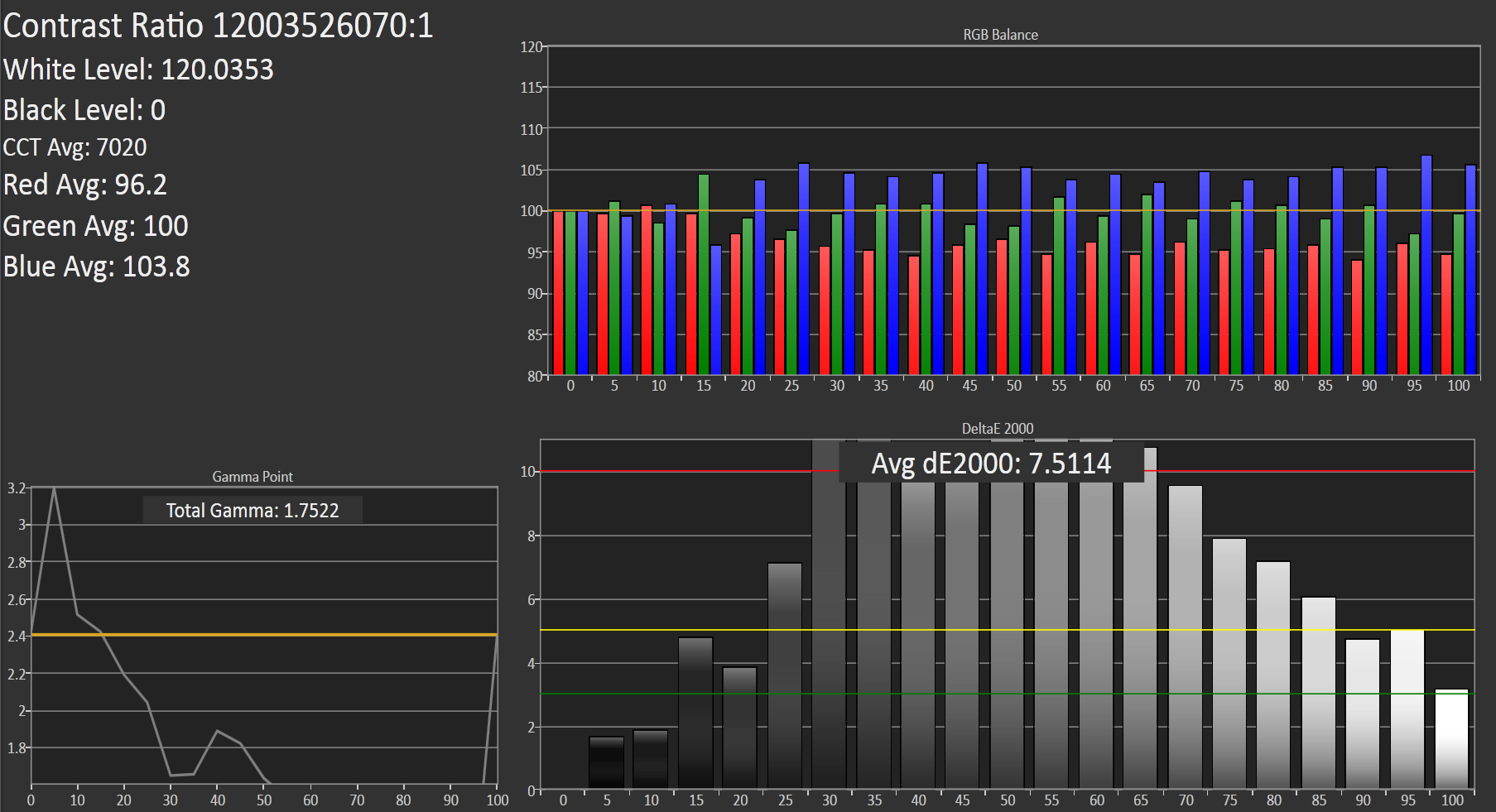








335 Comments
View All Comments
Crocography - Thursday, April 25, 2013 - link
I really wish Anadtech would start comparing all of these to the Nokia 920.GTRagnarok - Thursday, April 25, 2013 - link
What's part 2 going to be? Just the Exynos version?theduckofdeath - Thursday, April 25, 2013 - link
"he weight argument is an interesting one. If you compare the all-plastic Galaxy S 4 to the all-metal HTC One, there's a difference of 13 grams."The Samsung also has a much larger battery, which is the most dense and weight-adding element in a phone. It also has a larger display. So, the real benefit is a lot more than 13 grams.
scaramoosh - Thursday, April 25, 2013 - link
http://www.displaymate.com/Galaxy_S4_ShootOut_1.ht...What's that? The GS4 actually has an amazing screen?
risa2000 - Thursday, April 25, 2013 - link
My Galaxy Note 2 with Samsung charger charges in around two and half hour since the beginning until now (6 months). Could it be because of different power voltage (as I am in Europe on 230 V AC)?jleach1 - Thursday, April 25, 2013 - link
Why the heck would you call the inclusion of a mucroSD slot "disappointing"? What geek in their right mind would say that?And who in their right mind would pay $100 for an extra 16gb of NAND, when we all know it costs pennies, and we can buy a 32gb Class 10 card for $20?
ziggybiggunz - Thursday, April 25, 2013 - link
Its $100 more for an extra 32gb on the HTC actually, for a total of 64gbziggybiggunz - Thursday, April 25, 2013 - link
HTC One buyers have become a very vicious cohort. Some poor chap on youtube had to remove his voice and disable comment because be was getting death threats for disliking the One. Every single comparison video on youtube is loaded with " fuck you for liking the S4", "Samsung paid you to like it, you fuck", "fuck plastics", "fuck Samsung"....."fucking magnest, how do they work". These are the same people who not to long ago where sucking Samsungs dick over the GS2, Gnex, and the Note 1/2. Chill out. HTC One is good phone, but dont start shitting over samsung all of a sudden because someone came along and gave you a metal body. Was the pain of having your hipster friends making fun of your plastic phone becoming that unbearable? Before the One came out, Android users prime ammunition for iPhone users was the removable battery and expansion option, and all the "gimicks" of Samsung flagships. So samsung gave you that again, but used polycorbonate, so its chopped liver now? As soon as someone says anything good about the S4, you hear..."nope, its not aluminum like the One". Give me a break....remember who your daddy iscryosx - Sunday, April 28, 2013 - link
The HTC One deserves the praise but the extremists are kind of getting out of hand...bhima - Thursday, April 25, 2013 - link
Plastic is sort of bleh when it comes to this price bracket, but I feel Brian and Anand dismiss the desire for a removable battery too easily when comparing this phone to say the HTC One. On one hand, they say the removable battery isn't an issue because you upgrade your phone in 2 years (its implied), but on the other hand, they rightly make the point that we will most likely be buying these phones like how we buy computers in the near future due to carriers moving away from contracts. If this is the case, and we will be shelling out full retail, I would assume people would start to buy their phone like a computer and want to keep it LONGER than 2 years because they don't want to drop $300+ dollars on a new phone.Hell, the HTC One or the S4 are both such powerful phones that they could easily last much longer than 2 years, but the S4 is the only one that can actually last past this point... whereas the HTC One will be bricked due to a dying battery. I just find it strange that they had such great insight on how we will look at purchasing phones in the future without adding the foresight of battery concerns due to people keeping their phones longer.